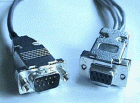A Cable Construction Trick
I have several TNCs and several radios, and
sometimes "mix-and-match" them. The problem is that I didn't
want to make a unique cable for each radio/TNC combination.
Instead I made just one cable for
each radio which terminates in a
male DB9 connector.
And I made just one cable
for each TNC which terminates in a
female DB9.

Then,
depending on which radio and TNC combination I want to use, I plug
the DB9 connectors together.
The key is to establish a common wiring plan for the DB9
connectors, something like:
|
Radios
TX audio
pin--> male DB9
pin 1
PTT pin---------> male DB9
pin 2
RX
audio
pin--> male DB9 pin 3
Ground pin----> male
DB9 pin 5
|
TNC or Sound Card
1 pin DB9 female
<---
TX audio pin
2
pin DB9
female <--- PTT pin
3
pin DB9 female <--- RX audio pin
5
pin DB9
female <--- Ground
pin
|
For my packet sound card cables,
I just adopted the TNC (DB9 female) scheme. I can now
plug my sound card cables into any of my radio cables
and run sound card packet on my mobile, base VHF, base HF or portable rigs!
I don't need to build a separate sound card interface for each
radio...just a separate radio connector.
Back to Cables: Getting
Started
|